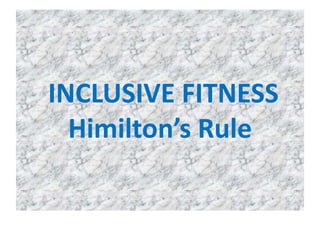
Inclusive Fitness Hamilton Rule
- 1. INCLUSIVE FITNESSHimilton’s Rule
- 2. A gene-centered view of evolution / existence! S. Butler, A chicken is an egg’s way of producing another egg’ An animal is a gene way of producing more copies of that gene And,Parental Care
- 3. Success in evolutionary terms means leaving offspring that themselves reproduce, but the 'success' of an individual is short-lived and ephemeral. In sexually reproducing species, an individual does not survive for more than one generation. But the genes are passed on to the future generations>>>>
- 4. Genetic variation in ('genes for') a tendency to defend young—perhaps mediated through variations in the level of a hormone —will result in a variation in the numbers of offspring that survive to pass on the favoured genes, and so on down the generations.
- 5. The direct line of parents to offspring is the only way that genes are passed on into the future, but direct parental care is not necessarily the only genetic strategy that will be successful. Helping a brother, sister, or other relatives to reproduce may also enable genes to perpetuate themselves.
- 6. Inclusive fitness Hamilton invented the idea of inclusive fitness. Fitness can be divided into two components: Direct fitness results from personal reproduction Indirect fitness results from additional reproduction by relatives, that is made possible by an individual’s actions.
- 7. Hamilton’s Rule The rule generalized the circumstances in which relative-helping of various sorts would evolve into the equation: Br - c > 0, Bis the benefit to the relative/actor and r is the coefficient of relatedness c the cost to the relative-helping genotype. The net benefit minus the cost must be positive(+) and greater than zero for the behavior to be favored. Where B is benefit to recipient and C is the cost to the actor. Unit of measurement for B and C is surviving offspring.
- 8. r b - c > 0, calculating values for r, b and c. rdoes not cause problem. r is the probability that the homologous alleles in two individuals are identical by descent. From basic genetics Full Siblings, and Parents & Offspring have a 50 per cent chance of sharing a given rare gene (r = 0.5); Nieces and Nephews have a 25 per cent chance of sharing with an uncle or an aunt (r = 0.25) and so on.
- 9. Calculating r To calculate r one should trace each path between the two individuals and count the number of steps needed. Then for this path r = 0.5 (number of steps) Thus, if two steps r for this path = 0.5 (2) = 0.25. To calculate final value of r one adds together the r values calculated from each path.
- 13. It is not just the degree of relatedness that matters, but the number of relatives that can be helped. Haldane, “ I am prepared to lay down my life on behalf of four grandchildren or eighth first cousins!”
- 14. r b - c > 0, values b and c More Problematic How to measure the effect of help. If we observe one animal helping another torear its yourn, how do we know that the parent wouldn’t have been just as scessful without the help? Ando how do we know whtat the cost to the helper was in terms of the offspring it wold have had if it hadn’t been helping someone else? The mythical offspring
- 15. r b - c > 0, values b and c, Some Practical Examples Hamilton on Isoptera(termites) and Hymenoptera(ants, bees, wasps) With Extreme Altruistic Behavior.
- 17. The 0.75 relatedness among Hymenoptera Sisters
- 18. How to Explain the sociality of Termites 1 0 0 0, 0 0 0 s Offspring
- 19. Naked Mole-rats Naked mole-rats are highly unusual mammals. They are nearly hairless and ectothermic. They are eusocial and, like termites, can digest cellulose with the help of bacteria in their gut.
- 20. Naked Mole Rats Fig 51.33
- 21. Naked Mole-rats The behavior of naked mole-rats is similar to that of colonial insects. There is a single reproductive female (queen) and 1-3 reproductive males. The remaining individuals act as workers. They dig tunnels to find food, defend the tunnel system from other mole-rats, and tend the young.
- 22. Naked Mole-rats Leading hypothesis for why naked mole-rats are eusocial is inbreeding. Average coefficient of relatedness is 0.81 and about 85% of matings are between parents and offspring or between full siblings.
- 23. Naked Mole-rats Despite high level of relatedness conflicts still occur because reproductive interests of workers and reproductives are not identical.
- 24. Naked Mole-rats Queens maintain control through physical dominance. Queen aggressively shoves workers who do not work hard enough and shoves are mainly directly towards less closely related individuals. Workers double their work rate after being shoved.
- 25. Naked Mole-rats In addition to inbreeding, ecological factors such as severely limited breeding opportunities and group defense appear to contribute to eusociality in naked mole-rats.
- 26. “We are survival machines—robot vehicles blindly programmed to preserve the selfish molecules known as genes”